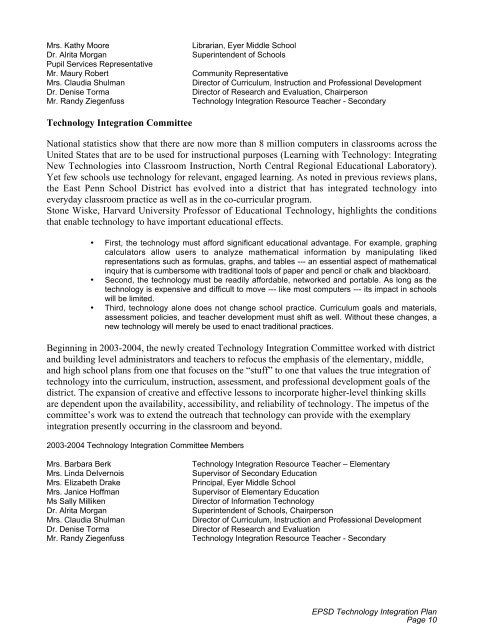EPSDtechintplan2004
EPSDtechintplan2004
EPSDtechintplan2004
You also want an ePaper? Increase the reach of your titles
YUMPU automatically turns print PDFs into web optimized ePapers that Google loves.
Mrs. Kathy Moore Librarian, Eyer Middle School<br />
Dr. Alrita Morgan Superintendent of Schools<br />
Pupil Services Representative<br />
Mr. Maury Robert Community Representative<br />
Mrs. Claudia Shulman Director of Curriculum, Instruction and Professional Development<br />
Dr. Denise Torma Director of Research and Evaluation, Chairperson<br />
Mr. Randy Ziegenfuss Technology Integration Resource Teacher - Secondary<br />
Technology Integration Committee<br />
National statistics show that there are now more than 8 million computers in classrooms across the<br />
United States that are to be used for instructional purposes (Learning with Technology: Integrating<br />
New Technologies into Classroom Instruction, North Central Regional Educational Laboratory).<br />
Yet few schools use technology for relevant, engaged learning. As noted in previous reviews plans,<br />
the East Penn School District has evolved into a district that has integrated technology into<br />
everyday classroom practice as well as in the co-curricular program.<br />
Stone Wiske, Harvard University Professor of Educational Technology, highlights the conditions<br />
that enable technology to have important educational effects.<br />
• First, the technology must afford significant educational advantage. For example, graphing<br />
calculators allow users to analyze mathematical information by manipulating liked<br />
representations such as formulas, graphs, and tables --- an essential aspect of mathematical<br />
inquiry that is cumbersome with traditional tools of paper and pencil or chalk and blackboard.<br />
• Second, the technology must be readily affordable, networked and portable. As long as the<br />
technology is expensive and difficult to move --- like most computers --- its impact in schools<br />
will be limited.<br />
• Third, technology alone does not change school practice. Curriculum goals and materials,<br />
assessment policies, and teacher development must shift as well. Without these changes, a<br />
new technology will merely be used to enact traditional practices.<br />
Beginning in 2003-2004, the newly created Technology Integration Committee worked with district<br />
and building level administrators and teachers to refocus the emphasis of the elementary, middle,<br />
and high school plans from one that focuses on the “stuff” to one that values the true integration of<br />
technology into the curriculum, instruction, assessment, and professional development goals of the<br />
district. The expansion of creative and effective lessons to incorporate higher-level thinking skills<br />
are dependent upon the availability, accessibility, and reliability of technology. The impetus of the<br />
committee’s work was to extend the outreach that technology can provide with the exemplary<br />
integration presently occurring in the classroom and beyond.<br />
2003-2004 Technology Integration Committee Members<br />
Mrs. Barbara Berk Technology Integration Resource Teacher – Elementary<br />
Mrs. Linda DeIvernois Supervisor of Secondary Education<br />
Mrs. Elizabeth Drake Principal, Eyer Middle School<br />
Mrs. Janice Hoffman Supervisor of Elementary Education<br />
Ms Sally Milliken Director of Information Technology<br />
Dr. Alrita Morgan Superintendent of Schools, Chairperson<br />
Mrs. Claudia Shulman Director of Curriculum, Instruction and Professional Development<br />
Dr. Denise Torma Director of Research and Evaluation<br />
Mr. Randy Ziegenfuss Technology Integration Resource Teacher - Secondary<br />
EPSD Technology Integration Plan<br />
Page 10


